APPS
10 No Code Creation Tools to Build Websites, Apps, and More

While you once had to be fluent in code to successfully build a website or an app, those days are now far behind us.
How?
Thanks to no-code creation tools.
These revolutionary interfaces allow users without classic programming backgrounds to build websites and apps through a graphical interface rather than using code.
The utility doesn’t stop there: No-code tools can help entrepreneurs and marketers achieve feats that in the past were reserved exclusively for programmers.
These tools also support automated processes, allowing organizations and individuals to save time by automating time-consuming tasks.
What’s better than time saved?
Money saved.
By eliminating programming fees and reducing billable hours spent on tedious processes, you can drastically reduce your costs.
Want to learn more?
In this post, we’ll unpack the 10 best no-code creation tools and what they can do for you.
Who Should Use No-Code Creation Tools?
The short answer: everyone.
If you don’t have a background in writing code or app development, don’t fret.
No-code tools provide users with visual interfaces that eliminate the need for a seasoned code writer.
Perhaps you want to launch a new personal website but are intimidated by the process behind the layout. There’s a no-code tool for that.
By using these tools, you can take website or app creation into your own hands, whether you’re familiar with code or not.
Even if you are familiar with code, these tools can help you automate tedious processes that bog down your daily workflow.
Benefits of No-Code Creation Tools
While we’ve already covered the obvious benefits of code-free creation tools, there are several other benefits to these tools that can have an impact on your business.
Increased Focus on Pain Point Solution
Rather than spending excessive amounts of time trying to find and hire the right programmer, you can focus on honing in on the true value of your app for your customer by identifying and speaking toward their pain point.
Reduce Development Cost
When you opt to use a no-code creation tool, you can plan to save a substantial amount of your budget previously dedicated to development needs. With low or no price points, these tools can make a significant difference in your bottom line.
Speed of Release
Not only will you save money when you use a code-free creation tool, you’ll also save time. Developing custom websites and apps is hard and time-consuming; using a tool with prebuilt templates is easy and saves countless hours.
Secure Environment
Regardless of what you’re building, a secure environment should be of the utmost importance. When you use no-code creation tools, safety nets are prebuilt into the platforms, allowing you peace of mind.
10 No-Code Creation Tools You Need to Try
There are a lot of no-code creation tools out there, all with different functions for different user groups. We picked out our top 10 favorites that help solve specific needs without having to write a line of code.
Bubble
When you use Bubble, you gain the ability to craft interactive apps for both desktop and mobile browsers.
With Bubble, you get design freedom without having to wrangle the intricacies of code.
While traditional web applications require a manual deployment process, Bubble manages deployment and hosting. The platform also offers limitless users, traffic volume, and data storage.
In short, this is your go-to for building production-ready apps.
Zapier
We’re fans of any tool that enhances connection and automation, which is why Zapier is on this list. With this tool, you can connect the apps you use daily.
Through “Zaps,” users sync Gmail with Dropbox, Dropbox with Slack and so on.
If you don’t use the above apps, don’t worry. Zapier connects thousands of apps.
By building these connections, workflow is simplified, saving you time and eliminating unnecessary processes.
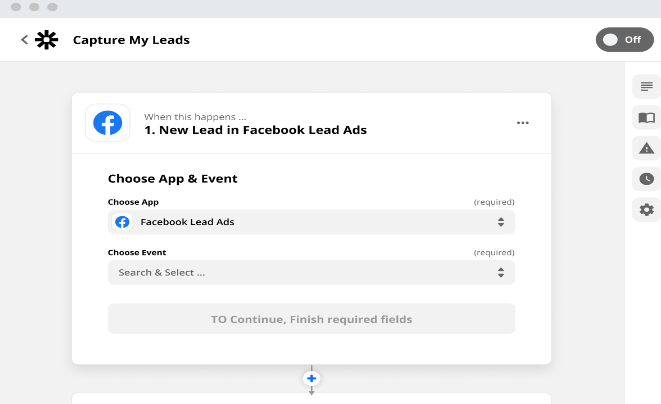
Stacker
This one is pretty cool. Stacker allows users to turn spreadsheets into apps, enabling you to securely share data with customers.
This lets you turn manual processes into automatic ones, streamlining onboarding and applications, enabling real-time collaboration, and ensuring secure file upload.
In essence, Stacker supports automation and collaboration through an easy-to-use, app-like interface that does all the coding for you.

Voiceflow
In need of a voice or chatbot? Voiceflow should be your go-to no-code creation platform. Regardless of what channel you’re using to reach your audience, Voiceflow designs, prototypes, and launches conversations for any channel.
With Voiceflow’s unique functionality, you can build engaging, contextually-layered conversation and voice apps to create an always-on interaction for your customers.
Additionally, you can standardize approach across sites, projects, and channels with the tools’ simple duplicative ability.
BugHerd
BugHerd helps you aggregate and implement website feedback.
This easy-to-use tracking tool enables users to instantly identify bugs through a visual component similar to a sticky note.
Comments will be pinned to the buggy element, allowing you to address issues directly from your website.
This tool also allows users to track given feedback on a list of bugs, ensuring you resolve issues as they arise.
Functionality includes adding comments, ranking bug severity, bug assignment, and report generation.
Perfect for the coder and non-coder alike, this tool makes bug removal a breeze.
SquareSpace
This easy-to-use website builder provides users with countless aesthetic templates to build the site of their dreams.
Whether you’re setting up a third-party extension or starting an e-commerce store, SquareSpace provides users with access to designer fonts and color palettes to allow for endless customization.
Equipped with an intuitive dashboard, SquareSpace also allows users to track visitors’ behavior and origin, allowing for a better understanding of the audience.
Once you’ve identified that audience, the platform comes equipped with social tools and email campaign builders to help you stand out among the crowd.
MemberSpace
This tool allows you to segment your website for different member groups.
Offering paid courses or video tutorials? Restrict access to payment groups with easy-to-use MemberSpace.
With MemberSpace, site owners control all member experiences, since members never move to an external site. They can login, manage access, and interact with content all from the safety of your site.
MemberSpace works across the content management system (CMS) tool continuum, so if you change platforms, you don’t have to change functionality.
Additionally, and perhaps predictably, given the tool’s purpose, users gain access to a private community that hosts conversations centered on the tool and membership topics.
Airtable
This online database allows collaborators to edit, store, and share information, whatever the term information means for the particular user group.
With similar functionality to an editable, online spreadsheet, users are invited to interact with Airtable.
While this tool may sound like other online spreadsheets, it has two distinct differences.
First, it’s easy-to-use nature instills in novices and experts alike feelings of proficiency.
Second, Airable allows users to manage databases, not sheets. Given the complexity of databases, the ability to handle them through simple, streamlined workflows is a boon to collaborative teams.
What’s more, the tool Airtable grows in tandem with teams, allowing increasing levels of sophistication as team needs evolve.
Parabola
Is your workflow bogged down by time-consuming manual processes?
If you answered yes, Parabola might be your new best friend.
This handy tool automates any task you can do in a spreadsheet.
Save time, reduce errors, and boost efficacy through automation. By using the tool’s drag-and-drop builder, routine reports and complicated tasks are all automated, allowing you to focus on what really matters: growing your business.
Payhere
Wading into the world of e-commerce? Payhere can help you get paid anytime, anywhere.
This no-code creation tool enables you to send a simple link across any medium (think video call, social media, email) and get paid.
The tool also features both one-time and recurring payments, making it easy for consumers to set up their payment schedules.
In addition to the overall payment functionality, Payhere allows users to create a simple, one-page storefront where all your payment links can be displayed. You can link to this storefront from your social platforms or in your email signature.
This simple tool is a must for you sellers out there.

No-Code Creation Tool Trends
It makes sense that the demand for low- and no-code tools will continue to grow since usage doesn’t demand extensive background.
In fact, Research and Markets reports the low-code market could be worth upward of $187 billion by 2030.
As the market for these platforms continues to skyrocket, here are the top three trends users of these tools should anticipate in the coming months and years:
1. Increased Adoption
As more and more consumers move away from traditional programming, you can anticipate increased availability and adoption of both no- and low-code platform models.
2. Rise of Automation
With the profusion of no-code tools with functionality to automate cumbersome, manual processes, expect to see a much more streamlined workforce.
3. Fusion Developer Teams
While developer teams have historically been made up solely of programmers, the rise of code-free creation tools is driving a more blended development team. By combining traditional coding with tools, organizations can build custom websites and apps that are created with a variety of different expertise.
Want to build an app, website, or other digital asset but don’t know how to code? Here are 10 tools to try.
- Bubble
Your go-to tool for building apps for desktop and mobile.
- Zapier
Connect apps, tools, and other programs to streamline your workflows.
- Stacker
Turn spreadsheets into apps and automate processes like onboarding and apps.
- Voiceflow
No-code chat bot or voice bot creator.
- BugHerd
Better understand web feedback with this easy-to-use tracking tool.
- SquareSpace
Build and launch your website in minutes with no coding experience.
- MemberSpace
Control the membership experience by integrating with your CMS>
- Airtable
Online data base that makes storing, editing, and managing information easier.
- Parabola
A handy tool to automate tasks from a spreadsheet to reduce errors and boost efficiency.
- Payhere
Get paid fast with a one-page storefront.
Conclusion
Regardless of where you work or what you do, it is inarguable that some function of your life can benefit from the offerings of the above 10 tools.
You no longer need a background in programming to accomplish your digital goals. As you start your next digital marketing campaign, ask yourself: Which processes can I automate to reduce manual workload and increase focus on overall success?
By answering this question, you’ll be able to isolate areas for improvement, optimizing your strategies and reducing manual processes.
What’s your favorite no- or low-code creation tool to use?
See How My Agency Can Drive Massive Amounts of Traffic to Your Website
- SEO – unlock massive amounts of SEO traffic. See real results.
- Content Marketing – our team creates epic content that will get shared, get links, and attract traffic.
- Paid Media – effective paid strategies with clear ROI.
APPS
Best ASO Tips To Boost Your App Search In 2022

You need your application to be really effective in the overpopulated application market. Then, at that point, you will have to drive downloads to endure. So when it’s all said and done, you must account for yourself. Get your application the consideration it merits.
The uplifting news, however, is that customers love to download applications – last year, we downloaded in excess of 200 billion applications around the world, and that figure is set to increment to 258 billion every year by 2022 as cell phone reception increments.
Assuming you need to be seen and have your application downloaded by however many clients as could reasonably be expected, then, at that point, you should begin by taking a gander at the application store.
Underneath, we’ve assembled probably the best application store improvement methods to assist you with creating more downloads in 2021 and then some…
Start with Your Application Name
The odds are you as of now have an extraordinary name for your application, yet an appropriately advanced application is about significantly more than marking.
Assuming you need to amplify transparency and guarantee you’re showing up when clients look for applications like yours, you ought to remember the primary keywords for your application name or title, comparable to how you’d make a title label while improving a site page.
You could begin with your application name so it tends to be plainly recognized, thus it appears on the home screen of gadgets.
Then, at that point, you can add a scramble or vertical bar prior to adding a few pertinent watchwords to your speciality, or even put your application name in quotes as we did with FORE Business Golf Networking.
Urge Users to Leave Reviews
You could ask for reviews by clients through the means of your site, or through an in-application notice toward the finish of their meeting, yet make sure to restrict the number of pop-ups you execute with the goal that you don’t disturb or disappoint your clients, as this could urge them to erase your application.
We’d support all application engineers and entrepreneurs to react to criticism on their applications, as this can further develop client relations and resolve issues in an open arena.
Zero in on Your Application Depiction
Your application depiction is your principle assemblage of text your landing page content, in a manner of speaking. Utilize a site like KeywordTool.io to discover information on your picked catchphrases to expand your openness. As portrayals are shortened, ensure you remember the main data for the initial three lines of your depiction, and afterwards add things like social confirmation, emoticon, and suggestions to take action to build commitment and downloads.
Incorporate Appealings Screen Captures
Pictures and recordings won’t help your application rank, yet they will expand changes and assist clients with working out whether it’s an application they truly need.
There’s a little guide in empowering clients toward downloading your application if in any case, they’re not going to interface with it, or download and leave a negative survey when they understand it wasn’t what was promoted.
Assuming you need to ‘tart up’ your item page, then, at that point, you can add marking and extra text and data and designs to your recordings and screen capture, yet they ought not to diminish your item.
Pay for App Store or Play Store
As we have SEO and pay-per-click, you need to work one next to the other (one is a gradual methodology with long haul benefits – the other is a speedy success yet requires an endless spending plan), application store promotions can be utilized to get the message out with regards to your new programming and assist you with positioning at the highest point of query items pages – in front of your opposition and enormous names in the application world.
Keep in mind, you’ll need to focus on the right crowd and art an advertisement that will assist you with changing over and that since you’re paying for situations, that doesn’t mean clients will download or cooperate with your application.
Wrapping Up!
You can employ a group of App Store Optimization Services suppliers to benefit a scope of application store improvement administrations, including watchword advancement, resource enhancement, and restriction to guarantee your application is seen by individuals that matter.
We have long periods of involvement in creating and showcasing applications and have assisted different customers with expanding their downloads by infiltrating rewarding and regularly undiscovered business sectors.
Author:
Prachi Gupta likes to write information about Digital Marketing Trends that can help audience to grow their business.
APPS
WhatsApp will finally let users encrypt their chat backups in the cloud
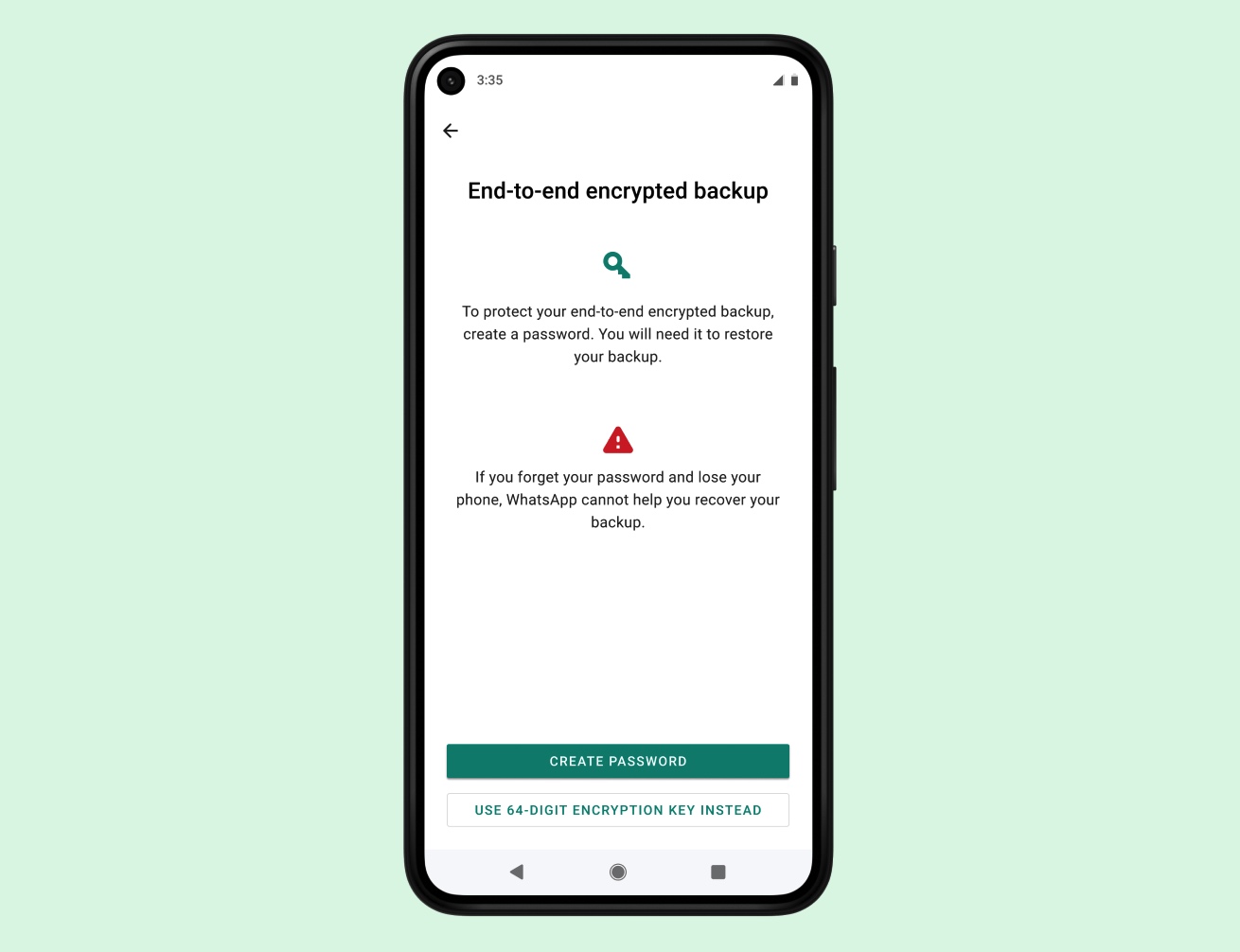
WhatsApp said on Friday it will give its two billion users the option to encrypt their chat backups to the cloud, taking a significant step to put a lid on one of the tricky ways private communication between individuals on the app can be compromised.
The Facebook-owned service has end-to-end encrypted chats between users for more than a decade. But users have had no option but to store their chat backup to their cloud — iCloud on iPhones and Google Drive on Android — in an unencrypted format.
Tapping these unencrypted WhatsApp chat backups on Google and Apple servers is one of the widely known ways law enforcement agencies across the globe have for years been able to access WhatsApp chats of suspect individuals.
Now WhatsApp says it is patching this weak link in the system.
“WhatsApp is the first global messaging service at this scale to offer end-to-end encrypted messaging and backups, and getting there was a really hard technical challenge that required an entirely new framework for key storage and cloud storage across operating systems,” said Facebook’s chief executive Mark Zuckerberg in a post announcing the new feature.
Store your own encryption keys
The company said it has devised a system to enable WhatsApp users on Android and iOS to lock their chat backups with encryption keys. WhatsApp says it will offer users two ways to encrypt their cloud backups, and the feature is optional.
In the “coming weeks,” users on WhatsApp will see an option to generate a 64-digit encryption key to lock their chat backups in the cloud. Users can store the encryption key offline or in a password manager of their choice, or they can create a password that backs up their encryption key in a cloud-based “backup key vault” that WhatsApp has developed. The cloud-stored encryption key can’t be used without the user’s password, which isn’t known by WhatsApp.
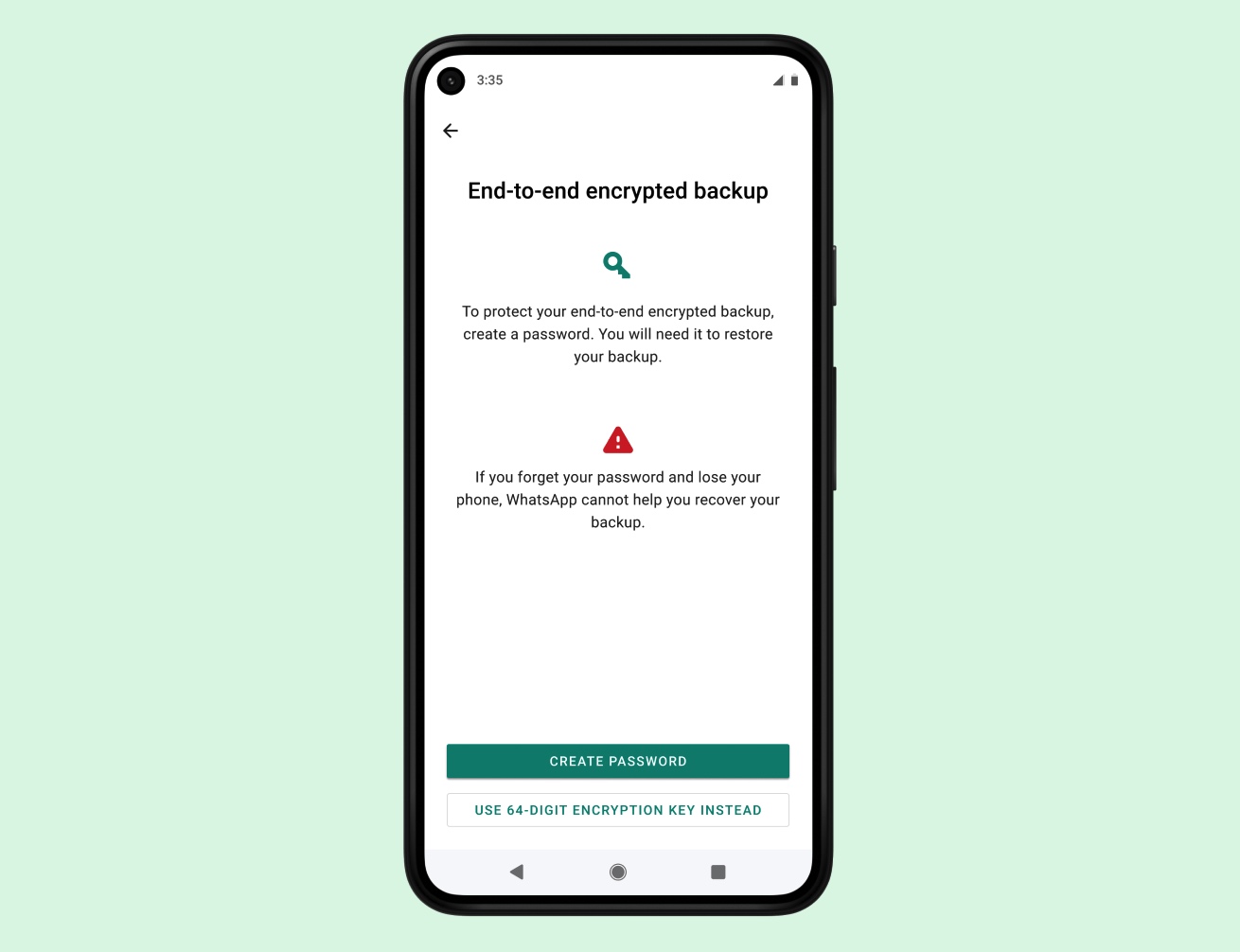
Image Credits: WhatsApp/supplied
“We know that some will prefer the 64-digit encryption key whereas others want something they can easily remember, so we will be including both options. Once a user sets their backup password, it is not known to us. They can reset it on their original device if they forget it,” WhatsApp said.
“For the 64-digit key, we will notify users multiple times when they sign up for end-to-end encrypted backups that if they lose their 64-digit key, we will not be able to restore their backup and that they should write it down. Before the setup is complete, we’ll ask users to affirm that they’ve saved their password or 64-digit encryption key.”
A WhatsApp spokesperson told TechCrunch that once an encrypted backup is created, previous copies of the backup will be deleted. “This will happen automatically and there is no action that a user will need to take,” the spokesperson added.
Potential regulatory pushback?
The move to introduce this added layer of privacy is significant and one that could have far-reaching implications.
End-to-end encryption remains a thorny topic of discussion as governments continue to lobby for backdoors. Apple was reportedly pressured to not add encryption to iCloud Backups after the FBI complained, and while Google has offered users the ability to encrypt their data stored in Google Drive, the company allegedly didn’t tell governments before it rolled out the feature.
When asked by TechCrunch whether WhatsApp, or its parent firm Facebook, had consulted with government bodies — or if it had received their support — during the development process of this feature, the company declined to discuss any such conversations.
“People’s messages are deeply personal and as we live more of our lives online, we believe companies should enhance the security they provide their users. By releasing this feature, we are providing our users with the option to add this additional layer of security for their backups if they’d like to, and we’re excited to give our users a meaningful advancement in the safety of their personal messages,” the company told TechCrunch.
WhatsApp also confirmed that it will be rolling out this optional feature in every market where its app is operational. It’s not uncommon for companies to withhold privacy features for legal and regulatory reasons. Apple’s upcoming encrypted browsing feature, for instance, won’t be made available to users in certain authoritarian regimes, such as China, Belarus, Egypt, Kazakhstan, Saudi Arabia, Turkmenistan, Uganda and the Philippines.
At any rate, Friday’s announcement comes days after ProPublica reported that private end-to-end encrypted conversations between two users can be read by human contractors when messages are reported by users.
“Making backups fully encrypted is really hard and it’s particularly hard to make it reliable and simple enough for people to use. No other messaging service at this scale has done this and provided this level of security for people’s messages,” Uzma Barlaskar, product lead for privacy at WhatsApp, told TechCrunch.
“We’ve been working on this problem for many years, and to build this, we had to develop an entirely new framework for key storage and cloud storage that can be used across the world’s largest operating systems and that took time.”
APPS
Dispo launches a test to gauge user interest in selling their photos as NFTs
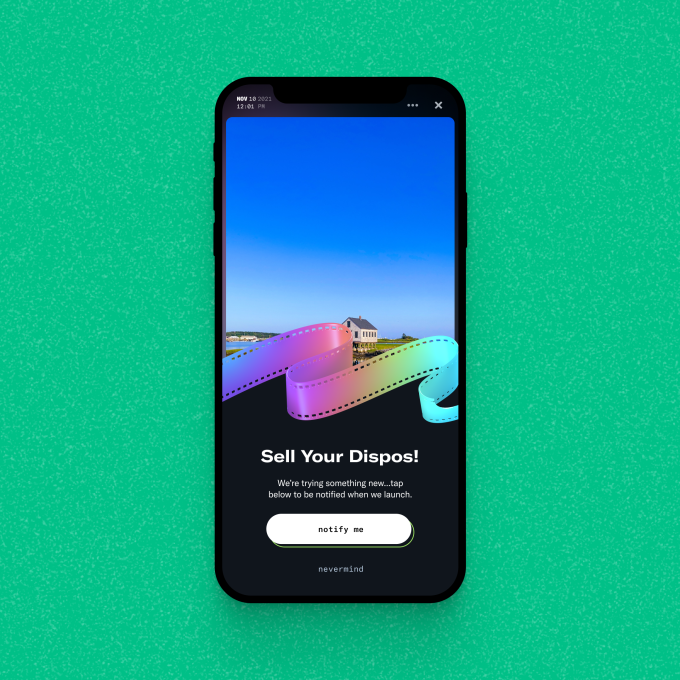
Dispo, the photo-sharing app that emulates disposable cameras, started rolling out a test yesterday that will record user interest in selling photos as NFTs. Some users will now see a sell button on their photos, and when they tap it, they can sign up to be notified when the ability to sell Dispo photos launches.
CEO and co-founder Daniel Liss told TechCrunch that Dispo is still deciding how it will incorporate NFT sales into the app, which is why the platform is piloting a test with its users. Dispo doesn’t know yet what blockchain it would use, if it would partner with an NFT marketplace or what cut of sales Dispo would take.
“I think it’s safe to say from the test that there will be an experience native to the Dispo app,” Liss said. “There are a number of ways it could look — there could be a native experience within Dispo that then connects through an API to another platform, and in turn, they’re our partner, but to the community, it would look native to the Dispo app.”
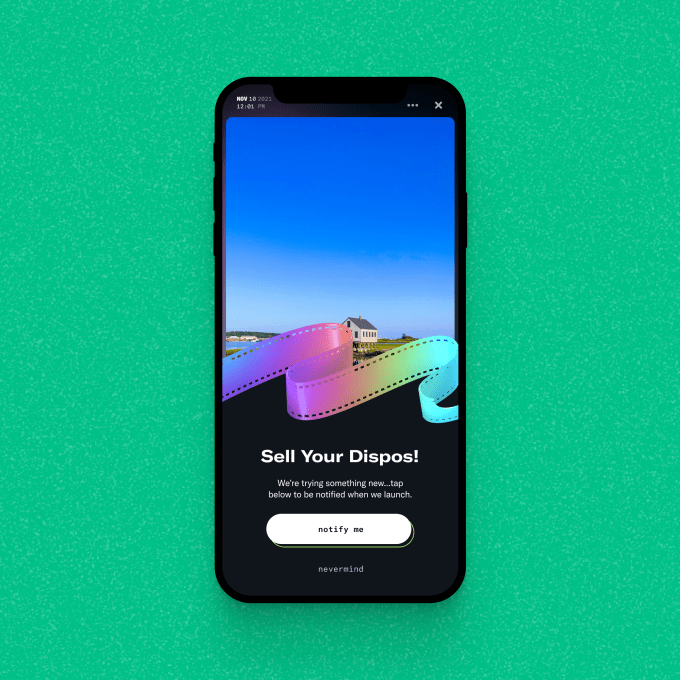
Image Credits: Dispo
This marks a new direction for the social media app, which seeks to redefine the photo-sharing experience by only letting users see the photos they took at 9 AM the next morning. From Dispo’s perspective, this gimmick helps users share more authentically, since you take one photo and then you’re done — the app isn’t conducive to taking dozens of selfies and posting the “best” image of yourself. But though it only launched in December 2019, Dispo has already faced both buzzy hype and devastating controversy.
Until about a year ago, the app was called David’s Disposables, named after co-founder and YouTuber David Dobrik. The app was downloaded over a million times in the first week after its release and hit No. 1 on the App Store charts. In March 2021, the app dropped its waitlist and relaunched with social network features, but just weeks later, Insider reported sexual assault allegations against a member of Vlog Squad, Dobrik’s YouTube prank ensemble. In response, Spark Capital severed ties with the company, leading to Dobrik’s departure. Other investors like Seven Seven Six and Unshackled Ventures, which contributed to the company’s $20 million Series A round, announced that they would donate any profits from their investments in Dispo to organizations working with survivors of sexual assault.
Liss told TechCrunch in June, when the company confirmed its Series A, that Dobrik’s role with the company was as a marketing partner — Liss has been CEO since the beginning. In light of the controversy, Liss said the app focused on improving the product itself and took a step back from promotion.
According to data from the app analytics firm SensorTower, Dispo has reached an estimated 4.7 million global installs to date since launch. Though the app saw the most downloads in January 2020, when it was installed over 1 million times, the app’s next best month came in March 2021, when it removed its waitlist — that month, about 616,000 people downloaded Dispo. Between March and the end of August, the app was downloaded around 1.4 million times, which is up 118% year over year compared to the same time frame in 2020 — but it should be expected that this year’s numbers would be higher, since last year, the app’s membership was exclusive.

Image Credits: Dispo
Now, with the announcement that Dispo is pursuing NFTs, Liss hopes that his company won’t just change how people post photos, but what the relationship will be between platforms and the content that users create.
“Why NFTs? The most powerful memories of our lives have value. And they have economic value, because we created them, and the past of social media fails to recognize that,” Liss told TechCrunch. “As a result, the only way that a creator with a big following is compensated is by selling directly to a brand, as opposed to profiting from the content itself.”
Adding NFT sales to the app offers Dispo a way to profit from a cut of user sales, but it stands to question how adding NFT sales could impact the community-focused feel of Dispo.
“I think there is tremendous curiosity and interest,” Liss said. “But these problems and questions are why we need more data.”
-

 MARKETING6 days ago
MARKETING6 days agoRoundel Media Studio: What to Expect From Target’s New Self-Service Platform
-

 SEO6 days ago
SEO6 days agoGoogle Limits News Links In California Over Proposed ‘Link Tax’ Law
-
SEARCHENGINES6 days ago
Daily Search Forum Recap: April 12, 2024
-

 SEO5 days ago
SEO5 days ago10 Paid Search & PPC Planning Best Practices
-

 SEARCHENGINES5 days ago
SEARCHENGINES5 days agoGoogle Core Update Volatility, Helpful Content Update Gone, Dangerous Google Search Results & Google Ads Confusion
-

 SEO7 days ago
SEO7 days agoGoogle Unplugs “Notes on Search” Experiment
-

 MARKETING6 days ago
MARKETING6 days ago2 Ways to Take Back the Power in Your Business: Part 2
-

 MARKETING4 days ago
MARKETING4 days ago5 Psychological Tactics to Write Better Emails














